Crystal structure of release factor RF3 trapped in the GTP state on a rotated conformation of the ribosome
- PMID: 22187675
- PMCID: PMC3264910
- DOI: 10.1261/rna.031187.111
Crystal structure of release factor RF3 trapped in the GTP state on a rotated conformation of the ribosome
Abstract
The class II release factor RF3 is a GTPase related to elongation factor EF-G, which catalyzes release of class I release factors RF1 and RF2 from the ribosome after termination of protein synthesis. The 3.3 Å crystal structure of the RF3·GDPNP·ribosome complex provides a high-resolution description of interactions and structural rearrangements that occur when binding of this translational GTPase induces large-scale rotational movements in the ribosome. RF3 induces a 7° rotation of the body and 14° rotation of the head of the 30S ribosomal subunit, and itself undergoes inter- and intradomain conformational rearrangements. We suggest that ordering of critical elements of switch loop I and the P loop, which help to form the GTPase catalytic site, are caused by interactions between the G domain of RF3 and the sarcin-ricin loop of 23S rRNA. The rotational movements in the ribosome induced by RF3, and its distinctly different binding orientation to the sarcin-ricin loop of 23S rRNA, raise interesting implications for the mechanism of action of EF-G in translocation.
Figures
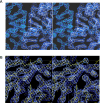
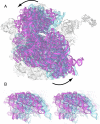
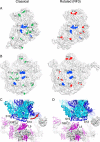

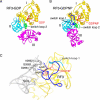
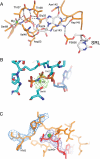


Comment in
-
Another burst of smoke: atomic resolution structures of RF3 bound to the ribosome.RNA. 2012 Apr;18(4):605-9. doi: 10.1261/rna.032011.111. Epub 2012 Feb 17. RNA. 2012. PMID: 22345149 Free PMC article.
Similar articles
-
Crystal structure of the hybrid state of ribosome in complex with the guanosine triphosphatase release factor 3.Proc Natl Acad Sci U S A. 2011 Sep 20;108(38):15798-803. doi: 10.1073/pnas.1112185108. Epub 2011 Sep 8. Proc Natl Acad Sci U S A. 2011. PMID: 21903932 Free PMC article.
-
RF3 induces ribosomal conformational changes responsible for dissociation of class I release factors.Cell. 2007 Jun 1;129(5):929-41. doi: 10.1016/j.cell.2007.03.050. Cell. 2007. PMID: 17540173
-
Dynamics of ribosomes and release factors during translation termination in E. coli.Elife. 2018 Jun 11;7:e34252. doi: 10.7554/eLife.34252. Elife. 2018. PMID: 29889659 Free PMC article.
-
[GTPases of translational apparatus].Mol Biol (Mosk). 2005 Sep-Oct;39(5):746-61. Mol Biol (Mosk). 2005. PMID: 16240709 Review. Russian.
-
Crystal structures of 70S ribosomes bound to release factors RF1, RF2 and RF3.Curr Opin Struct Biol. 2012 Dec;22(6):733-42. doi: 10.1016/j.sbi.2012.08.004. Epub 2012 Sep 19. Curr Opin Struct Biol. 2012. PMID: 22999888 Free PMC article. Review.
Cited by
-
Crystal structure of 70S ribosome with both cognate tRNAs in the E and P sites representing an authentic elongation complex.PLoS One. 2013;8(3):e58829. doi: 10.1371/journal.pone.0058829. Epub 2013 Mar 19. PLoS One. 2013. PMID: 23527033 Free PMC article.
-
Contribution of intersubunit bridges to the energy barrier of ribosomal translocation.Nucleic Acids Res. 2013 Jan 7;41(1):565-74. doi: 10.1093/nar/gks1074. Epub 2012 Nov 17. Nucleic Acids Res. 2013. PMID: 23161696 Free PMC article.
-
Conserved GTPase LepA (Elongation Factor 4) functions in biogenesis of the 30S subunit of the 70S ribosome.Proc Natl Acad Sci U S A. 2017 Jan 31;114(5):980-985. doi: 10.1073/pnas.1613665114. Epub 2017 Jan 17. Proc Natl Acad Sci U S A. 2017. PMID: 28096346 Free PMC article.
-
Structural characterization of ribosome recruitment and translocation by type IV IRES.Elife. 2016 May 9;5:e13567. doi: 10.7554/eLife.13567. Elife. 2016. PMID: 27159451 Free PMC article.
-
Crystal structures of EF-G-ribosome complexes trapped in intermediate states of translocation.Science. 2013 Jun 28;340(6140):1236086. doi: 10.1126/science.1236086. Science. 2013. PMID: 23812722 Free PMC article.
References
Publication types
MeSH terms
Substances
Grants and funding
LinkOut - more resources
Full Text Sources
Molecular Biology Databases
